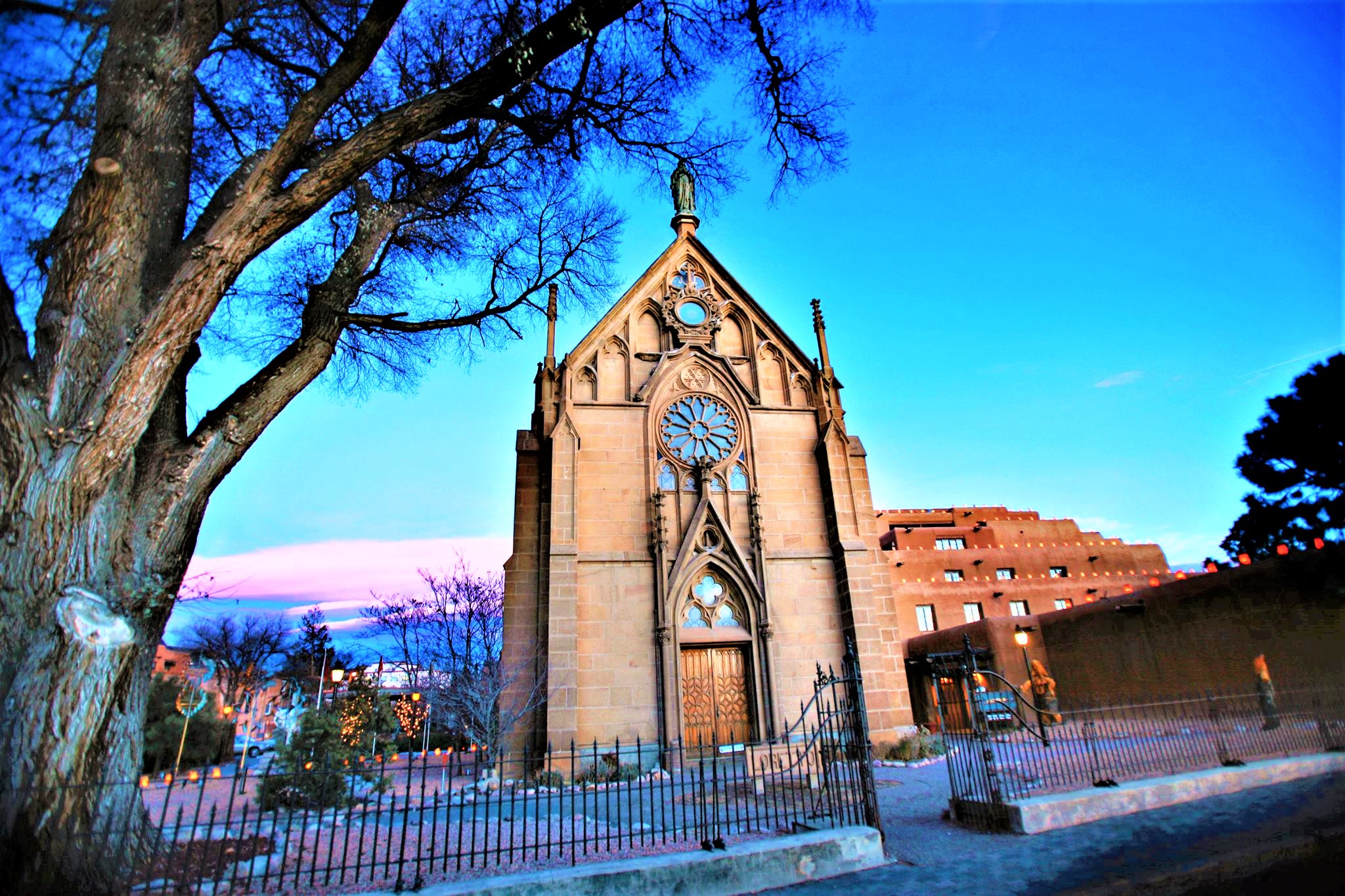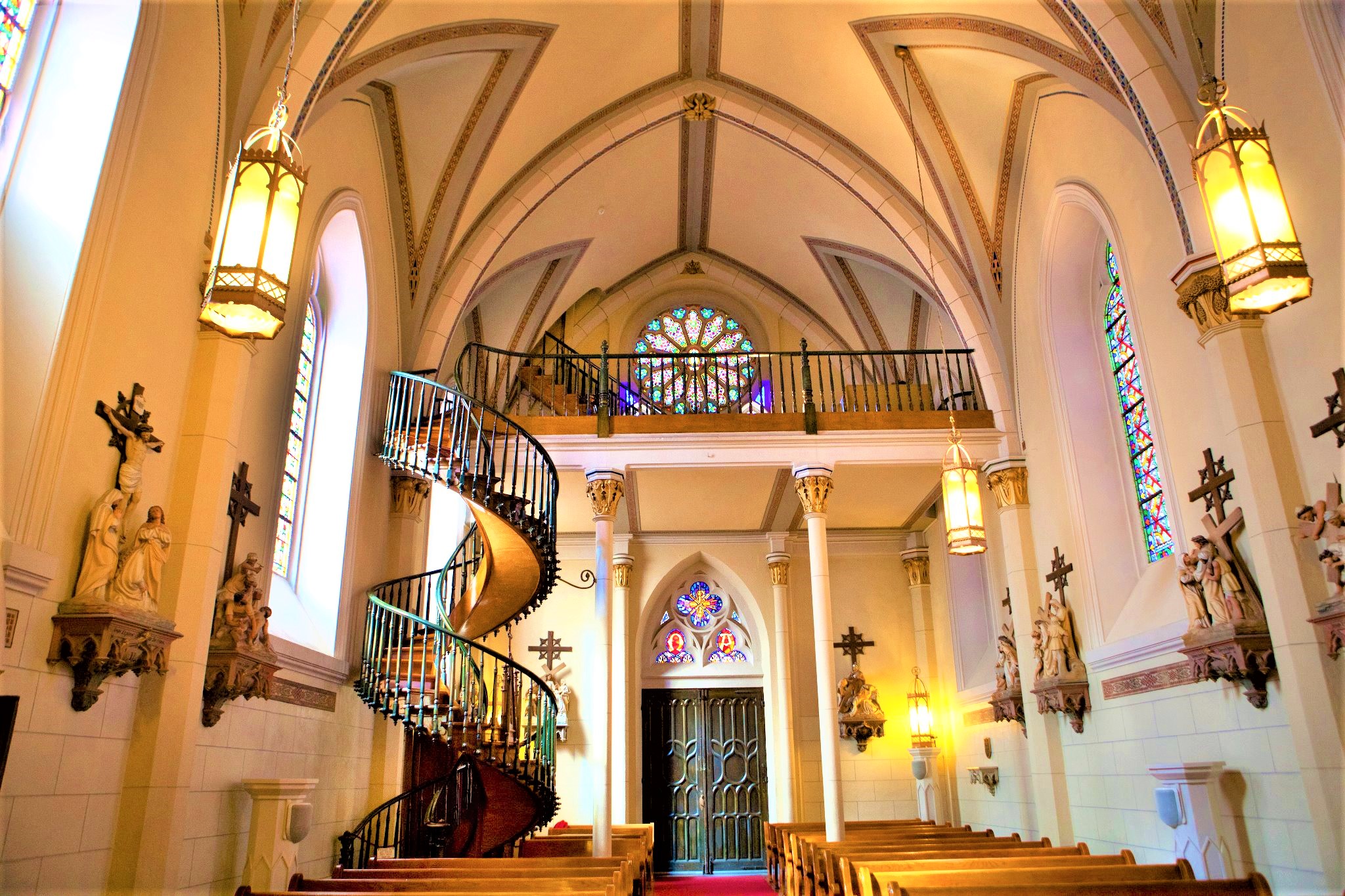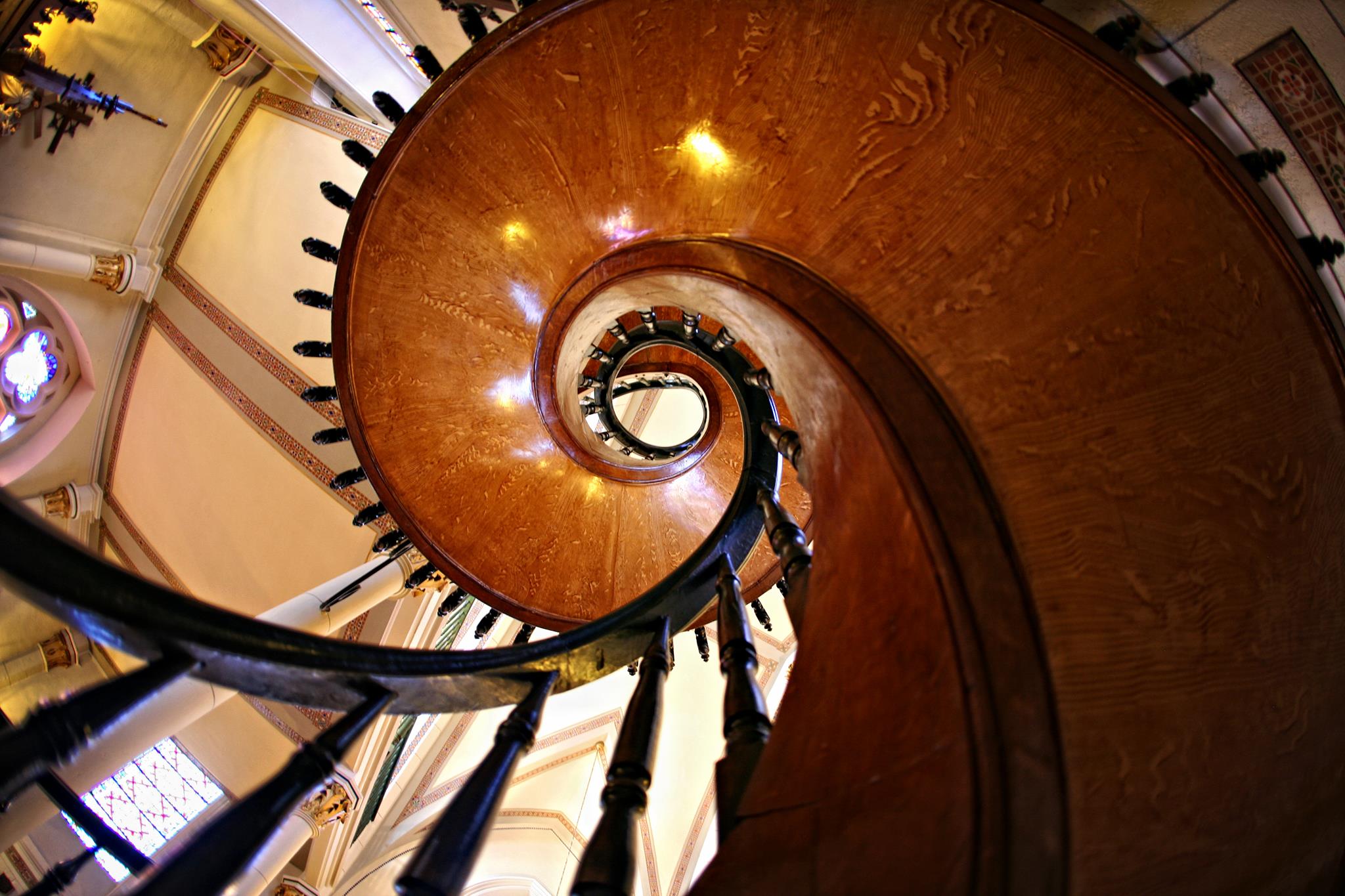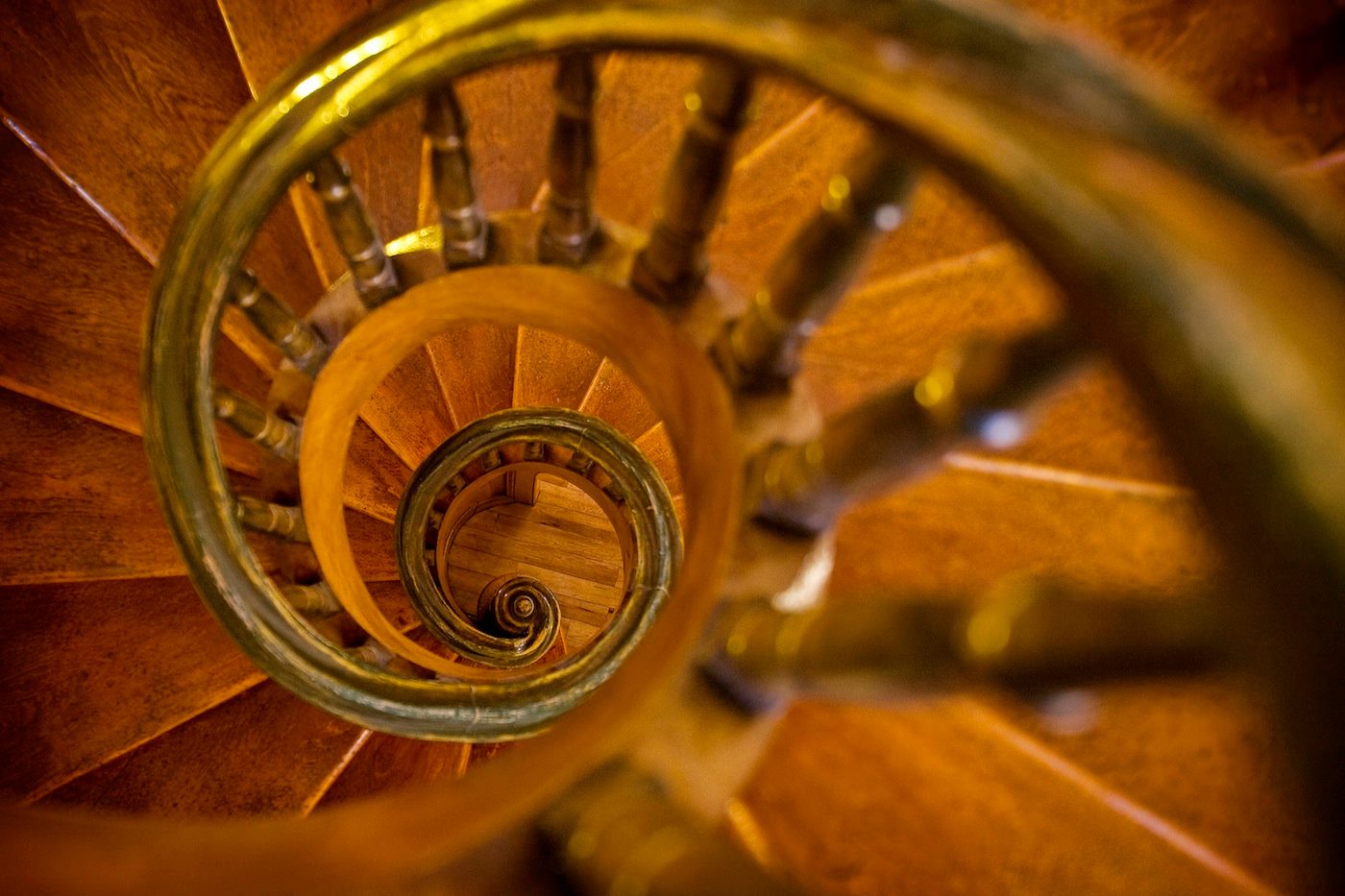EM – The spiral staircase, without a central pillar to support the weight, no glue or nails, just wooden dowels. Existing for more than 170 years, so far there has not been any explanation about the construction method, the materials that make up the staircase and even the identity of the carpenter is a mystery with no answer!
From faulty church blueprints…
Loretto Church at 207 Old Santa Fe Trail in the state of New Mexico in the southwestern United States, is a destination attracting millions of tourists. The highlight of the church is the magical spiral staircase that does not use nails or glue, but has an extraordinary bearing structure.
Built in 1878 with materials imported from France, the church is designed in the Gothic Revival style (also known as Victorian Gothic, neo-Gothic, or Gothick), the work of the French architect, Antoine Mouly. Despite its smaller scale, Loretto still has some typical architectural features like Notre Dame Cathedral in Paris.

Loretto Church, where the mysterious staircase is located
When the church was completed, the team of builders discovered that it was impossible to climb from the nave of the cathedral to the choir seats on the second floor. That is, the original design was faulty when not designing this staircase. The situation was made more difficult when the architect Antonio Mouly passed away. Building a traditional staircase is also difficult to do because the church is too small to have enough space. Finally, the builder advised to demolish the choir’s guard post. The church owners sought advice from local carpenters, but none could provide a viable solution.
…To the myths surrounding the staircase
According to anecdote, while church owners were struggling to find a way to fix faulty architectural drawings, a man came and offered to carry out the construction of a staircase to the 2nd floor choir. The strange thing is that this person asked to be alone in the chapel for 3 months, and with only simple tools including a saw, triangle and hammer.
For 3 months, the stranger locked himself inside the chapel and no one knew what he did, how to complete the wooden staircase. As soon as the stairs were completed, the mysterious carpenter quickly disappeared without regard to the remuneration. The nuns tried to find him but couldn’t. No one knows the carpenter’s identity and where he got the wood from.

Wooden staircase in the church
According to the story, when the nuns contacted local timber traders in the hope of finding out the whereabouts of the mysterious carpenter, no one provided any possible information. The wood used for the stairs is also not native.
According to another theory, female historian Mary J. Straw Cook spent 7 years researching the staircase in Santa Fe. She collected all kinds of data to prove the possible identity of the mysterious carpenter, writing a book titled: “Loretto: The Seven Sisters and Their Santa Fe Chapel”. Monastery and Santa Fe Chapel”, published in 1984. According to the historian, she found a line in the books of the nuns in 1881 whereby they paid for wood for a man named Rochas. Ms. Cook said that Mr. Rochas is a French carpenter who came to the US only because he wanted to build a staircase for the church in Santa Fe with wood imported from his home country of France.
Become the treasure of the world
The staircase of Loretto church is about 6 m high, has only 33 steps but twists to 2 complete 360-degree turns. Stairs are hammered and stand there without any nails or glue, and without the need for a central axis or horizontal beam as a support. The carpenter only used wooden pegs to secure the steps together. So far, no one has been able to explain why this structure can stand for hundreds of years without any support.
It can be said that the existence of the stairs goes against all the rules of physics, and almost anyone who sees it will think that the stairs will quickly collapse. When it was first built, the original stairs did not have handrails, and some of the nuns were so scared at first that they did not dare to walk upright, but crawled on both legs and arms. Ten years later, the nuns added a handrail, and the outer helix was supported by a nearby pillar.
Even the staircase material is an unsolved mystery. Although the steps are believed to be made of spruce, no one has been able to determine exactly which species of spruce the tree belongs to, or how the wood appeared inside the church.


This magical spiral staircase after 150 years is still mysterious
Years later, the church’s curator took a piece of wood from the stairs and sent it off for analysis to find out what kind of wood it was. Results showed it to be spruce, but an unspecified subspecies. This particular wood is very sturdy with dense and square particles – a very slow growing tree in very cold places like Alaska.
However, such wood is not found in the area and the surrounding area. The closest place one can find this wood is in Alaska, nearly 6000 km from the church site, but back then the traffic was not as developed as it is now and certainly the wood could not be transported over such long distances.
The nuns of Loretto’s church attributed the stairs to a miracle, a sacred concept that seemed to transcend the laws of nature, and they believed that the man who came to create the stairs was a man sent from heaven. Although that miracle seems to be a myth, the spiral staircase, with its unsolved mysteries, has persisted for more than 150 years, despite the calamity of speculation about its origin and magic.
Despite conflicting information, the staircase has still become a “treasure” in the world, receiving the attention and love of millions of people and becoming the subject of countless novels. There was even a 1998 movie The Staircase based on the true story of the staircase./.
Le Hung




Paul Michael Bharath
I’m going to see it by God’s grace!
I believe in the legend that it was built by St. Joseph,,
Angela Casey
I believe that the carpenter was St Joseph ,the sisters made a 9 days novena to the Saint and He answered ..
Tawanah Bagwell
I was so glad to get to visit this chapel and to see the staircase. It is amazing.
Lynda Murphy
How beautiful are the stairs! A wonder!
I’ve been blessed to see them.
Fran Pultro
It was a mystery until around the 1960s. I’ve probably got that date incorrect. A carpenter from the Midwest – I believe he was a Swedish immigrant from Minnesota or whichever state it is with a large Swedish populace – built it. He never told anyone including his family. When his family was going through his tools after his death they came across his drawings for the staircase. My dad was a member of the Carpenter’s Union. He often told me about the mystery. He followed the story for decades & was a devout Catholic who believed it was a miracle & that the builder was St. Joseph. He was surprised, but not disappointed to learn that the mystery of this staircase had been solved.
Angela VanBrunt
I believe St. Joseph built the stair case he was a Carpenter